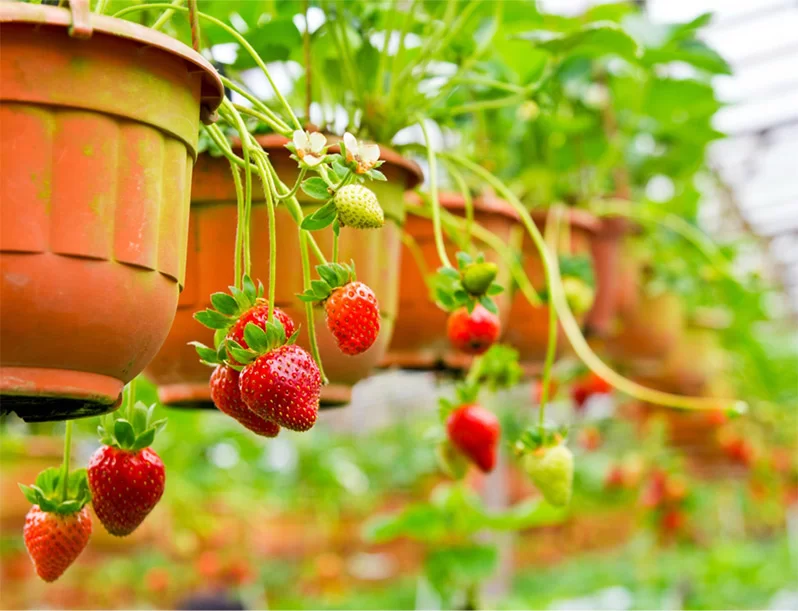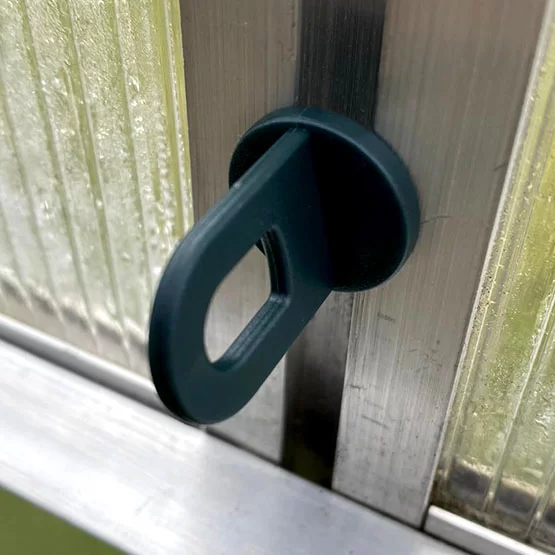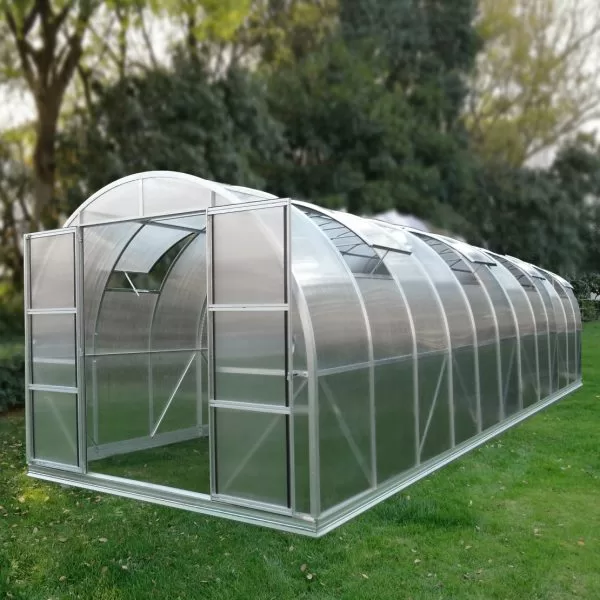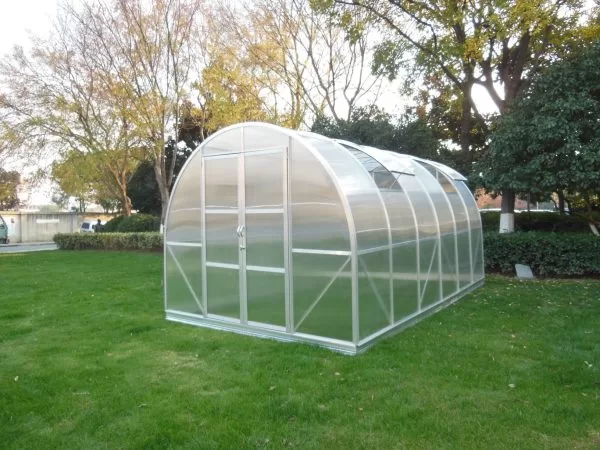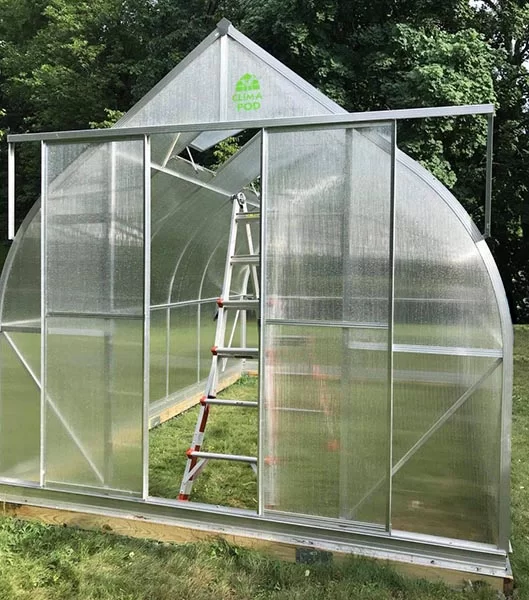Recently, more and more gardeners have been paying attention to an unusual way of growing plants – vertical gardening. It’s like green vegetable gardens, but not on the ground, but on the walls of buildings. Such “gardens in the sky” are not only beautiful, but also effective: they help save space, resources and make urban spaces green and well-groomed.
The idea of vertical gardening is not new – it came to us from ancient times, just remember the glorious Hanging Gardens of Babylon. Since then, it has continued to develop, adapting to the modern world and helping to cope with the environmental challenges of our time.
Let’s figure out how to grow plants in vertical greenhouses! This is an exciting activity, full of interesting nuances: what plants can be planted, how to care for them, what systems to use. We will also talk about why it is important to control the temperature and lighting in the greenhouse to ensure optimal conditions for plants to grow vertically
With the planet’s average temperature increasing and the need to shift to sustainable agricultural practices, vertical gardening in greenhouses is becoming an important topic for gardeners and farmers. Let’s dive into this topic together and see how you can make your vertical greenhouses a success!
Advantages of vertical gardening in greenhouses
Greenhouse vertical gardening offers many benefits for both growers and the environment. These benefits can be divided into four main areas: space optimization, improved growing conditions, increased yield and productivity, and environmental benefits. In this section, we’ll look at each of these categories in detail.
Space optimization
Higher plant density per square meter
By growing plants vertically, growers can significantly increase the number of plants they can grow in a given area. Vertical gardening allows for more efficient use of greenhouse space by providing a higher density of plants per square foot. This is especially true in urban environments, where land is rare and expensive.
Efficient use of greenhouse space
Vertical gardening also allows for better use of vertical space within the greenhouse, which can be especially beneficial for crops that require significant height, such as tomatoes or cucumbers. In addition, efficient use of space can result in lower costs since a smaller greenhouse area can produce the same or greater volume of production compared to traditional horizontal growing methods.
Improved growing conditions
Better air circulation
Vertical gardening promotes better air circulation around plants, reducing the risk of fungal diseases and other airborne pathogens. This is especially important in greenhouse environments where control of humidity and temperature is critical for optimal plant growth.
Improved light distribution
Growing plants vertically ensures even distribution of light, as opposed to horizontal growing methods in which taller plants may shade shorter ones. This more even distribution of light can lead to increased photosynthesis and overall plant health.
Make pest control easier
Placing plants vertically can make pest monitoring and control easier by making them more visible and accessible. Additionally, improved air circulation and light distribution can help create conditions less conducive to pests.
Increased yield and productivity
Higher yields
Thanks to improved growing conditions and increased plant density, vertical gardening in greenhouses can result in increased yield per square meter. This may result in more production for consumption or sale.
Faster growth
The improved growing conditions associated with vertical gardening can also help speed up plant growth rates. When plants are provided with optimal light, nutrients and air circulation, they are likely to grow faster, reducing the time between planting and harvest.
Increasing harvest frequency
With faster growth rates and higher yields, vertical gardening can allow growers to harvest more frequently, ensuring a continuous supply of fresh produce. This can be especially beneficial for commercial businesses that rely on a stable income stream.
Environmental benefits
Reduce water use
Vertical gardening systems, especially hydroponic ones, often require less water than traditional soil-based growing methods. Closed-loop systems allow water and nutrients to be recycled, resulting in reduced water use and waste.
Reducing soil erosion
Because many vertical gardening systems use little or no soil, they help reduce soil erosion and degradation. This is especially important in regions where maintaining soil quality is a key issue.
Reducing your carbon footprint
Vertical gardening in greenhouses can help reduce your carbon footprint because fewer resources are required to maintain the growing environment. Additionally, the potential for growing food closer to urban centers reduces the need for transportation, further reducing greenhouse gas emissions.
Overall, the benefits of vertical greenhouse gardening are numerous and include space optimization, improved growing conditions, increased productivity, and environmental benefits. As a result, vertical gardening is becoming an increasingly attractive option for growers looking to maximize their yields, minimize their environmental footprint, and make the most of limited space.
Vertical gardening systems for greenhouses
There are many vertical gardening systems available for greenhouses, each with its own unique benefits and requirements. These systems can be broadly divided into three main categories: hydroponic systems, soil-based systems and combination systems.
| System type | Description | Advantages |
|---|---|---|
| Hydroponic systems | Systems that use an aqueous solution of nutrients to feed plants, without the use of soil. | Fast plant growth, less water use, nutrient control, ability to grow without soil. |
| Soil-based systems | Systems that use soil or soil-like media to grow plants in vertical structures. | Suitable for most types of plants, natural nutrition, easy to maintain and care. |
| Combined systems | Systems that combine elements of hydroponics and soil, such as aeroponics or aquaponics. | Combines the advantages of hydroponic and soil systems, providing flexibility in the choice of plants and growing methods. |
In this section we will look at each of these categories and provide examples of specific systems within them.
Hydroponic systems
Hydroponic systems are soilless growing methods that rely on the use of nutrient-rich water solutions to deliver essential nutrients directly to the roots of plants. These systems can be particularly well suited for vertical gardening in greenhouses due to their compact design and reduced water use. Some common hydroponic vertical gardening systems include:
- Nutrient Film Technique (NFT)
The nutrient film technique involves growing plants in shallow channels or tubes with a thin film of nutrient water flowing continuously over the roots. This system ensures efficient nutrient delivery and root oxidation, promoting healthy plant growth. - Aeroponics
Aeroponics is a hydroponic system in which plant roots are suspended in the air and periodically sprayed with nutrient water. This system provides excellent oxidation and nutrient delivery, resulting in faster plant growth and greater yield. - Drip systems
Drip systems use a network of pipes and nozzles to deliver nutrient water directly to the roots of plants grown in containers or other media. This method allows for precise control of water and nutrient delivery, making it an effective option for vertical gardening in greenhouses.
Soil-based systems
Soil-based systems use traditional growing media such as soil or compost and can be adapted for vertical gardening in greenhouses. Some common soil-based vertical gardening systems include:
- Vertical wall pots
Vertical wall planters are modular systems with individual planting pockets or containers mounted on a wall or frame. They can be filled with soil or other growing media and used to grow a variety of plants, from leafy greens to small fruiting plants. - Terrace system
Terraces are made up of multiple layers of planting containers stacked on top of each other, creating a terraced vertical garden. These systems can be used with soil or other growing media and are suitable for a wide range of plants. - Trellis systems
Trellis systems use vertical supports such as posts, wire or mesh to provide structure for climbing and climbing plants that grow upward. This method is ideal for plants such as tomatoes, cucumbers and beans that naturally grow vertically and can benefit from additional support.
Combined systems
Combination systems combine elements of hydroponic and soil systems, offering gardeners the ability to choose the most appropriate aspects of each system for their specific needs. Some examples of combined systems include:
- Vertical towers for farming
Vertical farming towers are self-supporting, multi-level growing systems that can support both soil and hydroponic growing methods. They often include built-in irrigation systems and can accommodate a wide range of plant species. - Modular systems
Modular systems are customizable vertical horticultural solutions that can be adapted to suit different growing methods, plant species and greenhouse spaces. These systems can include components such as wall planters, container stackers and hydroponic elements, allowing gardeners to create a custom vertical garden that suits their specific needs.
Choosing the right vertical gardening system for your greenhouse
When choosing a vertical gardening system for your greenhouse, consider factors such as the types of plants you want to grow, the space available, your budget, and your preferred growing method (soil-based or hydroponics). Each system has its own unique benefits and limitations, so it’s important to weigh your options and choose the one that best suits your goals and preferences.
Suitable plants for vertical gardening in greenhouses
When selecting plants for vertical gardening in a greenhouse, there are several factors to consider, such as light, humidity and temperature requirements, as well as the plants’ overall growth characteristics. Here are some plants that work well for vertical gardening in a greenhouse:
- Leafy Vegetables</strong
Lettuce, spinach, kale and kale are excellent candidates for vertical gardening. They do not require much space to grow and can thrive in a greenhouse environment. - Herbs
Many culinary herbs, such as basil, parsley, cilantro and mint, can successfully grow vertically and adapt well to greenhouse conditions. - Climbing
Plants such as cucumbers, squash and peas naturally grow vertically and can benefit from the extra support provided by vertical systems. - Flowers
Some types of flowers, such as petunias, geraniums and fuchsias, can be grown vertically in greenhouses. They add aesthetic appeal and can also be useful in attracting beneficial insects and improving biodiversity. - Small fruiting plants
Some types of tomatoes, peppers and strawberries can grow successfully in vertical systems and greenhouses. However, please note that large-fruited varieties may require additional support or may not be suitable for some vertical systems.
The main idea when choosing plants for vertical gardening in a greenhouse is to choose those that can grow successfully in a greenhouse environment and adapt to vertical space.
| Plant type | Examples | Required temperature |
|---|---|---|
| Leafy green vegetables | Lettuce, spinach, cabbage | 15-20°C |
| Herbs | Basil, parsley, mint | 15-25°C |
| Small fruiting plants | Strawberries, dwarf varieties of tomatoes and peppers | 18-27°C |
| Climbing and climbing plants | Cucumbers, peas, beans | 15-25°C |
| Compatibility factor | Description |
|---|---|
| Light requirements | Consider the light requirements of plants and group plants with similar needs together to ensure even lighting. |
| Water and nutrient requirements | Consider your plants’ water and nutrient needs by grouping plants with similar needs together to make them easier to care for. |
| Growth Habits | Consider the growth habits of each plant, including their height, spreading, and climbing or climbing tendencies, and plan your vertical garden accordingly. |
| Plant size and weight | When choosing plants for your vertical garden, consider the size and weight of the plants to ensure they will fit your structure without overwhelming it. |
In addition to choosing suitable plants, it is also important to ensure that they are compatible with each other. Some plants can grow together successfully, providing mutual support and complementing each other, while others may compete for resources or adversely affect each other. Here are some guidelines for plant compatibility in vertical greenhouse gardening:
- Diversity
Plant diversity will help improve biodiversity and provide mutual support, as well as reduce the likelihood of the spread of diseases and pests. - Different resource requirements
Provide a variety of plants with different resource requirements such as light, water and nutrients. This will help prevent competition for resources and ensure healthy growth of each plant. - Root interactions</strong
Consider each plant’s root system when planning your vertical garden. Plants with short root systems, such as leafy vegetables and herbs, can coexist well in vertical systems, while plants with deeper root systems, such as perennials, may require more space. - Plant Rotation
Consider rotating your plants, especially if you are growing fruit-bearing vegetables such as tomatoes, peppers and strawberries. Rotating plants will help prevent soil nutrient depletion and reduce the risk of disease and pests. - Combination of beneficial plants
Some plants may offer additional benefits, such as attracting beneficial insects, repelling pests or improving soil quality. Consider growing these plants together for maximum benefit.
Maintenance and care of vertical gardens in greenhouses
Proper maintenance and care of vertical gardens in greenhouses is critical to ensure successful plant growth and development. Here are some key aspects to consider when maintaining and caring for a vertical garden:
- Water
Vertical gardens may require more frequent watering as plants may have a harder time retaining moisture in vertical systems. Make sure to properly distribute moisture throughout your vertical garden and water regularly to ensure optimal hydration. - Feeding
Like any garden, plants in vertical gardens require regular feeding to maintain healthy growth. Make sure to apply the correct nutrients based on the needs of your specific plants and the vertical gardening system you are using. Hydroponic systems may require special nutrient solutions, while soil-based systems may require traditional fertilizers or compost. - Temperature and Light Control
Controlling the temperature and light in a greenhouse is critical to providing optimal growing conditions for plants, especially for vertical gardens. Consider the light and heat needs of specific plants, and adjust them accordingly using heating, ventilation and lighting systems. - Pruning and Maintaining Plant Shape
Regular pruning and maintaining the shape of plants in a vertical garden will help ensure even distribution of light, prevent overcrowding and improve the overall appearance of the garden. Monitor the health of the plants and remove dry or damaged parts. - Pest and Disease Control
Proactive pest and disease control will help prevent their spread and keep your vertical garden healthy. Check plants regularly for signs of pests or diseases.
Greenhouse vertical gardening offers many opportunities to improve the productivity and sustainability of agricultural practices. From choosing the right vertical gardening system to maintaining optimal growing conditions and effective management, successful vertical gardening in a greenhouse requires attention to detail and strategic planning. With the development of this innovative agricultural practice and ongoing improvements in technology, vertical greenhouse gardening is becoming increasingly accessible and successful for gardeners of all experience levels.
Recommendations for choosing a greenhouse model for vertical gardening
ClimaPod Virtue greenhouse series is more suitable for vertical growing. They have enough vertical space to install vertical systems. The greenhouse provides sufficient lighting for plants at all levels and has good ventilation to maintain optimal temperature and air circulation. Virtue is very strong and stable to support the weight of vertical structures and plants.
Climapod Virtue 9×14 & 9×21 Greenhouse Series With 6-mm Polycarbonate
An easy way to try vertical growing in a greenhouse is to use hanging pots. They are secured to the frame using hooks or carabiners threaded through hanging clips like this:

